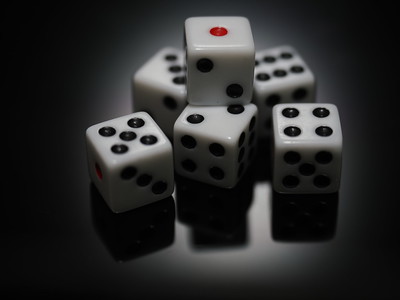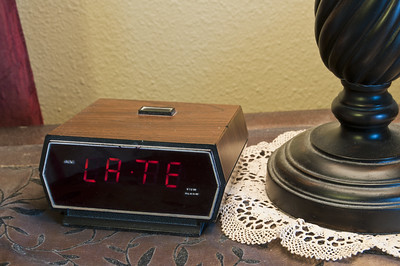Posts Tagged ‘Competitiveness’
Decisions, Decisions, Decisions
 If a decision can be unmade, it’s okay to make it quickly.
If a decision can be unmade, it’s okay to make it quickly.
Delaying a decision is a decision.
When a decision remains unmade, there’s a reason. However, that reason is often unspoken.
The effort to make the right decision is proportional to the consequences of getting it wrong.
Decisions are sometimes made without the non-deciders realizing that they were made.
Trouble arises when the decision maker is not the customer of the consequences.
Decisions are made slowly when people are afraid to make them.
When you don’t know a decision was made, you’ll continue to behave as if it wasn’t.
If five people are responsible for the decision, who is responsible for the decision?
Even if you are unaware that a decision was made, you’ll likely be expected to behave as if you knew it was.
If no decisions will be made at the meeting, don’t go. Just read the minutes.
Documenting decisions is not standard work, but I think it should be.
Decisions can be made, not made, unmade, re-made, and re-unmade.
Decisions aren’t decisions until behavior aligns with them.
When a decision is yet to be made, you can influence the decision by behaving as if it was made in your favor.
If you wait long enough, the decision will make itself.
Image credit — yawning hunter
996 or Bust
 996 is all the rage. You work 9 am to 9 pm, 6 days a week. Startups are doing it. Might non-startups start doing it?
996 is all the rage. You work 9 am to 9 pm, 6 days a week. Startups are doing it. Might non-startups start doing it?
Productivity is important and competition is severe. And I’m all for working hard, but I don’t think the 996 schedule is the most effective way to achieve productivity goals, at least not for all jobs.
My decision-making capabilities diminish when I am tired, and I would be tired if I worked a 996 schedule. My interpersonal and organizational effectiveness would suffer if I worked 996. My planning skills would degrade if I worked 996. My family life would suffer if I worked 996. And my physical and mental health would degrade..
In my work, I make many decisions, I create conditions for teams and organizations to do new work, and I contemplate the future and figure out what to do next. Maybe I should be able to do this work well with a 996 schedule. But I know myself, and I know I would be far less effective working 996. Maybe my work is uniquely unfit for 996? Maybe I am uniquely unfit for 996?
Some questions for you:
- How many hours can you concentrate in one day?
- How about the second day?
- If you worked a 996 schedule, would you get more done?
- How many weeks could you work 996 before the wheels fall off?
The startup pace is rapid. Progress must be made before the money runs out. At these early stages, when a company’s existence depends on hitting the super agressive timelines, I think 996 is especially attractive to startup companies The potential financial upside is large which may make for a fair trade – more hours for the chance of outsized compensation.
But what if an established company sets extremely tight timelines and offers remarkable compensation if those timelines are met? Does 996 become viable? What if an established company sets startup-like timelines but without added compensation? Would 996 be viable in that case?
Some countries and regions work a 996 schedule as a matter of course – no limited to startups and (likely) no special compensation. And it seems to work for them, at least from the outside. And 996 may be an important supporting element of their impressively low costs, high quality, and speed.
If those countries amd regions can sustain their 996 culture, and I think they will, it will create pressure on other countries to adopt a similar approach to avoid falling further behind.
I’m unsure what broad adoption of 996 would mean for the world.
Image credit — Evan
When Your Plans Must Change….
 To do new things, you’ve got to stop old things.
To do new things, you’ve got to stop old things.
If you don’t stop old things, you can’t start new things.
Resources limit the work that can be done.
If you have more work than resources, you won’t be able to complete everything.
Spread your resources across fewer projects, and you’ll accomplish more.
If you run more projects, you’ll get fewer done. Resource density matters.
For new behavior to start, old behavior must stop.
If you don’t stop old behavior, you can’t start new behavior.
When your standard work no longer works, it becomes non-standard work.
When it’s time for new work, non-standard work becomes standard work.
To get more done, improve efficiency.
To get the right work done, improve effectiveness.
New behavior requires a forcing function.
No forcing function, no change.
Things change at the speed of trust.
No trust, no change.
Transformational change isn’t a thing.
Evolutionary change is a thing.
Starting new projects is easy.
Finishing new projects requires stopping/finishing old ones, which is difficult.
Creating a start-doing list is common.
Creating a stop-doing list is unheard of.
Image credit — Demetri Dourambeis
Getting To Know Your Projects

Good new product development projects deliver value to customers. Bad ones create value for your company, not for customers. Can you discern between custom value and company value? What do you do when there’s an abundance of company value and a shortfall of customer value? Do you run the project anyway or pull the emergency brake as soon as possible?
Customers decide if the new product has value. That’s a rule. No one likes that rule, but it’s still a rule. The loudest voice doesn’t decide; it only drowns out the customer’s voice.
Having too many projects is worse than having too few. With too few, you finish projects quickly because shared resources are not overutilized. With too many, shared resources are overbooked, their service times blossom, and projects are late. Would you rather start two projects and finish two or start seven and finish none? That’s how it goes with projects.
Three enemies of new product development: waiting, waiting, waiting. Waiting that extends the critical path is the worst flavor of all. Can you tell when the waiting is on the critical path? If you calculate the cost of delay, it’s possible to spend money to eliminate waiting that’s on the critical path and make more money for your company. H/T to Don Rienertsen.
For projects, effectiveness is more important than efficiency. Yes, you read that correctly. Would you rather efficiently run the wrong project (low effectiveness) or run the right project inefficiently? Do you spend more mental energy on efficiency or effectiveness? (You don’t have to say your answer out loud.)
I think post-mortems of projects have no value. The next project will be different, and the learning will not be applicable or forgotten altogether. However, I think pre-mortems are powerful and can improve the effectiveness of a project BEFORE it is started. I suggest you try it on your next project.
Strategy is realized through projects. Projects generate growth. Cost savings come to life through projects. I think building a deeper understanding of your projects is the most important thing you can do.
Image credit — Mike Keeling (one too many head on collisions)
Solving The Wrong Problem
 The CEO doesn’t decide if it’s good enough. The VP of Marketing doesn’t decide if it’s good enough. The VP of Engineering doesn’t decide if it’s good enough. The customer decides if it’s good enough.
The CEO doesn’t decide if it’s good enough. The VP of Marketing doesn’t decide if it’s good enough. The VP of Engineering doesn’t decide if it’s good enough. The customer decides if it’s good enough.
If the product isn’t selling, the price may be okay, but the performance may not be good. In this case, it’s time to add some sizzle. And who decides if the sizzle is sufficient? You guessed it – the customer. And if you add the sizzle and they buy more, the sizzle was the problem. If they don’t buy more, it wasn’t the sizzle.
If the product isn’t selling, the performance may be okay, but the price may be too high. In this case, it’s time to pull some cost out of the product and reduce the price. Maybe a better way is to test a lower price with customers. If they buy more, it’s worth doing the work to pull out the cost. If they don’t buy at the lower price, the price isn’t the problem. You still have some work to do.
If the product isn’t selling, both the performance and the price may be the problem. It’s time to add some sizzle and lower the price. But there’s no need to do the work until you test the hypothesis. Make a one-page sales tool with the new sizzle and price. If they like it, make it so. If they don’t like it, make another sales tool with some different sizzle and a different price. Repeat the process until the customer likes the new offering. Then, make it so.
If the product isn’t selling, it’s possible the sales channel isn’t making enough money when they sell your product. To test this, go on several sales calls with them. If they are unwilling to bring you on the sales calls, it’s a good sign that there’s not enough money in it for them. There are three ways to move forward. Reduce the price to the channel partner. If they sell more, you’re off to the races if, of course, there is enough margin in the product to support the reduced price. Make it easier for them to sell your product so they spend less time and effort and make more profit. Sell through a different channel.
When your product isn’t selling, figure out why it isn’t selling. And because there are many possible reasons your product isn’t selling, it’s best to create a hypothesis and test it. Your job is not to solve the problem; rather, your job is to figure out what the problem is and to decide whether it’s worth solving.
If you create a one-page sales tool with a lower price and customers still don’t want to buy it, don’t bother to design out the cost or reduce the price. If you create a one-page sales tool with a new DVP and the customers still don’t want to buy it, don’t do the work to develop that new DVP. If you test a reduced price to the channel and they sell a few more systems, don’t reduce the price because it’s not worth it.
Once you have objective evidence that you know what the problem is and it’s worth solving, do the work to solve it and implement the solution. If you don’t have objective evidence that you know what the problem is, it’s not yet time to solve it.
There’s nothing worse than solving the wrong problem. And the customer decides if the problem is worth solving.
Image credit — Geoff Henson
How To Put The Business Universe On One Page
 When I want to understand a large system, I make a map. If the system is an ecosystem, I combine Wardley Maps by Simon Wardley with Wide Lens / Winning The Right Game by Ron Adner. On Wardley maps, activities and actors are placed on the map, and related elements are connected. On the left are infant and underdeveloped elements, and on the right are fully developed / commodity elements. It’s like an S-curve that’s been squished flat.
When I want to understand a large system, I make a map. If the system is an ecosystem, I combine Wardley Maps by Simon Wardley with Wide Lens / Winning The Right Game by Ron Adner. On Wardley maps, activities and actors are placed on the map, and related elements are connected. On the left are infant and underdeveloped elements, and on the right are fully developed / commodity elements. It’s like an S-curve that’s been squished flat.
Wide Lens prompts you to consider co-innovation (who needs to innovate for you to be successful) and adoption (who needs to believe your idea is a good one). Winning The Right Game makes you think through the sequence of attracting partners like a visual time-lapse of the ecosystem’s evolution. This is a killer combination that demands you put the whole system on one page – all the players/partners, all the activities sorted by maturity, all the interactions, and the evolution of the partner network and maturity of the system elements. This forces a common understanding of the ecosystem. There’s no way out. Did I say it must fit on one page?
When the large system is a technological system, I make a map. I use the best TRIZ book (Innovation On Demand) by Victor Fey. A functional analysis is performed on the system using noun-verb pairs that are strung together to represent how the system behaves. If you want to drive people crazy, this is the process for you. It requires precise words for each noun (element) and verb (action) pair, and the pairs must hang together in a way that represents the physical system. There can be only one description of the system, and the fun and games don’t stop until the team converges on a single representation of the system. It’s all good fun until someone loses an eye.
When I want to understand a business/technology/product/service offering that has not been done before (think startup), I use Lean Canvas by Ash Maurya. The Lean Canvas requires you to think through all elements of the system and forces you to put it on one page. (Do you see a theme here?) Value proposition, existing alternatives, channel to market, customer segments, metrics, revenue, costs, problems, and solutions – all of them on one page.
And then to blow people’s minds, I combine Wardley Maps, Wide Lens, Winning The Right Game, functional analysis of TRIZ, value in action, and Lean Canvas on one page. And this is what it looks like.

Ash’s Lean Canvas is the backplane. Ron’s Wide Lens supports 6 (Channel), forcing a broader look than a traditional channel view. Ron’s Winning The Right Game and Simon’s Wardley Map are smashed together to support 2 (Existing Alternatives/Problems). A map is created for the existing system with system elements (infants on the left, retirees on the right) and partners/players, which are signified by color (red blob). Then, a second map is created to define the improvements to be made (red circles with arrows toward a more mature state). Victor’s Functional Analysis/System diagram defines the problematic system, and TRIZ tools, e.g., Separation Principles, are used to solve the problem.
When I want to understand a system (ecosystem or technological system), I make a map. And when I want to make a good map, I put it on one page. And when I want to create a new technological system that’s nested in a new business model that’s nested in a new ecosystem, I force myself to put the whole universe on one page.
Image credit – Giuseppe Zeta
Good Teachers Are Better Than Good
 Good teachers change your life. They know what you know and bring you along at a pace that’s right for you, not too slowly that you’re bored and not too quickly that your head spins. And everything they do is about you and your learning. Good teachers prioritize your learning above all else.
Good teachers change your life. They know what you know and bring you along at a pace that’s right for you, not too slowly that you’re bored and not too quickly that your head spins. And everything they do is about you and your learning. Good teachers prioritize your learning above all else.
Chris Brown taught me Axiomatic Design. He helped me understand that design is more than what a product does. All meetings and discussions with Chris started with the three spaces – Functional Requirements (FRs) what it does, Design Parameters (DPs) what it looks like, and Process Variables (PVs) how to make it. This was the deepest learning of my professional life. To this day, I am colored by it. And the second thing he taught me was how to recognize functional coupling. If you change one input to the design and two outputs change, that’s functional coupling. You can manage functional coupling if you can see it. But if you can’t see it, you’re hosed. Absolutely hosed.
Vicor Fey taught me TRIZ. He helped me understand the staggering power of words to limit and shape our thinking. I will always remember when he passionately expressed in his wonderful accent, “I hate words!” And to this day, I draw pictures of problems and I avoid words. And the second thing he taught me is that a problem always exists between two things, and those things must touch each other. I make people’s lives miserable by asking – Can you draw me a picture of the problem? And, Which two system elements have the problem, and do they touch each other? And the third thing he taught me was to define problems (Yes, Victor, I know I should say conflicts.) in time. This is amazingly powerful. I ask – “Do you want to solve the problem before it happens, while it happens, or after it happens?” Defining the problem in time is magically informative.
Don Clausing taught me Robust Design. He helped me understand that you can’t pass a robustness test. He said, “If you don’t break it, you don’t know how good it is.” He was an ornery old codger, but he was right. Most tests are stopped before the product fails, and that’s wrong. He also said, “You’ve got to test the old design if you want to know if the new one is better.” To this day, I press for A/B testing, where the old design and new design are tested against the same test protocol. This is much harder than it sounds and much more powerful. He taught me to test designs at stress levels higher than the operating stresses. He said, “Test it, break it, and improve it. And when you run out of time, launch it.” And, lastly, he said, “Improve robustness at the expense of predicting it.” He gave zero value to statistics that predict robustness and 100% value to failure mode-based testing of the old design versus the new one.
The people I work with don’t know Chris, Victor, or Don. But they know the principles I learned from them. I’m a taskmaster when it comes to FRs-DPs-PVs. Designs must work well, be clearly defined by a drawing, and be easy to make. And people know there’s no place in my life for functional coupling. My coworkers know to draw a picture of the problem, and it better be done on one page. And they know the problem must be shown to exist between two things that touch. And they know they’ll get the business from me if they don’t declare that they’re solving it before, during, or after. They know that all new designs must have A/B test results, and the new one must work better than the old one. No exceptions.
I am thankful for my teachers. And I am proud to pass on what they gave me.
Image credit — Christof Timmermann
Change the plan or stay the course?
 Plans are good, until they’re not. The key is knowing when to stay the course and when to adjust the plan.
Plans are good, until they’re not. The key is knowing when to stay the course and when to adjust the plan.
The time horizons for strategic plans or corporate initiatives can range from two to five years. To ensure we create the best plans, we assign the work to our best people, we provide them with the best information, and we ask them to use their best judgment. As input, we assess market fundamentals, technology trends, customer segments, our internal talent, our partners, our infrastructure, and our processes. We then set revenue targets and create project plans and resource allocation plans to realize the revenue goals. And then it’s go time.
We initiate the projects, work the plans, and report regularly on the progress. If the progress meets the monthly goal, we keep going. And if the progress doesn’t meet the monthly goal, we keep going. We invested significant time and effort into the plan, and it can be politically difficult, if not bad for your career, to change the plan. It takes confidence and courage to call for a change to a strategic plan or a corporate initiative. But two to five years is a long time, and things can (and do) change over the life of a plan.
A plan is created with the best knowledge available at the time. We assess the environment and use the knowledge to set the financial requirements for the plan. When the environment and requirements change, the plan should change.
Before considering any changes, if we learn that the assumptions used to create the plan are invalid, the plan should change. For example, if the resource allocation is insufficient, the timelines should be extended, resources should be added, or the scope of the work should be reduced. I think changing the plan is responsible management, and I think it’s irresponsible management to stay the course.
The environment can change in many ways. Here are five categories of change: tariffs, competition, internal talent (key people move on), new customer learning, and new technical learning (e.g., more technical risk than anticipated). Significant changes in any of these categories should trigger an assessment of the plan’s viability. This is not a sign of weakness. This is responsible management. And if the change in the environment invalidates the plan’s assumptions, the plan should change.
The specification (revenue targets) for the plans can change. There are at least two flavors of change: an increase in revenue goals or a shorter timeline to achieve revenue goals, which are usually caused by changes to the environment. And when there’s a need for more revenue or to deliver it sooner, the plans should be assessed and changed. Again, I think this is good management practice and not a sign of failure or weakness. When we realize the plan won’t meet the new specification, we should modify the plan.
When we learn the assumptions are wrong, we should change the plan. When the environment changes, we should change the plan. And when the specification changes, we should change the plan.
Image credit — Charlie Day
How It Goes With New Ideas
 When your idea is new, it (and you) will be misunderstood. I urge you to see the misunderstanding as a vote of confidence. Keep going.
When your idea is new, it (and you) will be misunderstood. I urge you to see the misunderstanding as a vote of confidence. Keep going.
When your position contradicts the mainstream, say it anyway. They’ll appreciate your honesty and courage if you work at a good company. If you work at a bad company, they’ll probably try to run you out of town. Either way, you’ll know what kind of company you’re working for.
Change is difficult when the Status Quo has been successful for a long time. Success will block your new idea because there’s no need for it. Working on your new idea pulls resources away from the Status Quo’s initiatives, and the Status Quo will have none of that. Don’t take its wrath personally. That’s how the Status Quo goes about its business.
When your new idea is young, it is too fragile to be justified in an ROI sense. Shelter it from the Accounting Police.
Your new idea isn’t right. It starts the journey as one thing, and as the journey progresses, it will transform into something better. This is how it goes with new ideas.
Without a new idea, you’ll do what you did last time. That’s no way to live.
If no one complains, your idea isn’t new. You missed the mark.
If some complain but none are threatened, it’s not new enough. Try harder.
Image credit – denisben
Partners can be more important than product when selling into new applications.

We all want to increase top-line revenue by selling more. But we’ve been selling our existing products into the same old applications for a long time now, and we’ve reached a hard limit – when we add more effort, we get little in return. Developing an entirely new product will take a long time, so we will try to sell our existing products into new applications. We will have to change our product slightly to make it work in the new applications, but we can do that quickly. We have a good plan.
We search the globe for these new applications and find a winner. It’s a new application in which our product has a technological advantage over the existing products. The new value is clear to the customer, and they want to get rid of their existing products and replace them with our flagship product. Our product requires minimal changes, which we’ve already implemented. Our product is ready to sell! Let’s go! Let’s get after it. Not so fast.
As it turns out, the customers don’t know how to use our product, they don’t know how to install it, and they don’t have a way to buy the consumables and maintenance parts. Before we can sell, we must figure out a way to get the products installed, to train the operators, to find a way to sell the wear parts and consumables, and to service the product. As it turns out, with this new application, there are a lot of missing elements to the go-to-market system.
When selling into new applications, it’s not all about the product. It’s all about the partners. It’s about finding and developing partners familiar with the industry, the application, and the customers. But it’s tricky. You are unfamiliar with the application and don’t know how to find these partners. Once you identify them, they are unfamiliar with your product, how it’s installed, how it’s operated, and how it’s serviced.
It takes time and effort to educate, train, and develop a new partner. They may know the customer, but they don’t know the ins and outs of your product. And they need to educate, train, and develop you. You may know your product, but you don’t know the customers and the ins and outs of the application.
These new applications can create incremental revenue for you and your new partners, and that’s exciting. But at the early stages of development, these new applications require more time and investment than we’re used to. The profitability equation will take some time to realize its full potential. And to realize that full potential, be sure to create a go-to-market model that is profitable for your partner. An unprofitable partner can’t afford to be a good partner. And you need good partners.
Image credit — TMAB2003
Improvement In Reverse Sequence
 Before you can make improvements, you must identify improvement opportunities.
Before you can make improvements, you must identify improvement opportunities.
Before you can identify improvement opportunities, you must look for them.
Before you can look for improvement opportunities, you must believe improvement is possible.
Before believing improvement is possible, you must admit there’s a need for improvement.
Before you can admit the need for improvement, you must recognize the need for improvement.
Before you can recognize the need for improvement, you must feel dissatisfied with how things are.
Before you can feel dissatisfied with how things are, you must compare how things are for you relative to how things are for others (e.g., competitors, coworkers).
Before you can compare things for yourself relative to others, you must be aware of how things are for others and how they are for you.
Before you can be aware of how things are, you must be calm, curious, and mindful.
Before you can be calm, curious, and mindful, you must be well-rested and well-fed. And you must feel safe.
What choices do you make to be well-rested? How do you feel about that?
What choices do you make to be well-fed? How do you feel about that?
What choices do you make to feel safe? How do you feel about that?
Image credit — Philip McErlean
 Mike Shipulski
Mike Shipulski